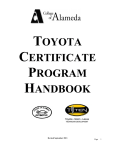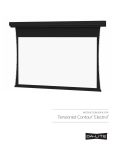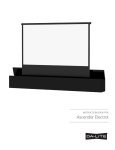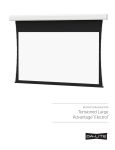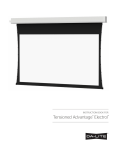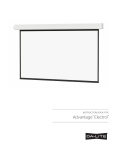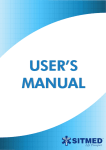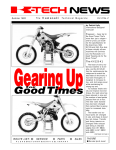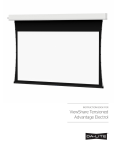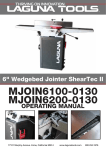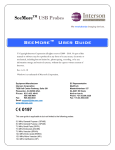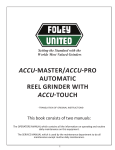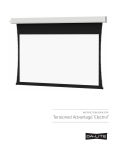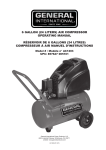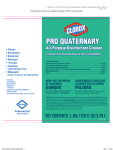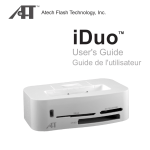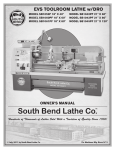Download Atech Program Student Handbook
Transcript
ATECH PROGRAM HANDBOOK Revised September 2013 Page 1 Table of Contents Section 1. 2. 3. 4. 5. 6. 7. 8. 9. 10. 11. 12. Page Automotive Staff Program Description Certificates and Degrees Annual Schedule Tuition and Fees Attendance Policy Associate Degree Required Tool List Emergency Procedures Safety Rules Shop Rules and Regulations Rules of Conduct 2 3 4 5 6 7 7 8 10 11 15 17 A UTOMOTIVE T ECHNOLOGY D EPARTMENT S TAFF I NSTRUCTORS Rufino Ramos Rick Greenspan Ed Jaramillo Wayne Fung John Peterson John Taylor EM AIL O FFICE P HONE Q UALIFICATIONS rramos@peralta.edu rgreenspan@peralta.edu ejaramillo@peralta.edu wfung@peralta.edu jpeterson@peralta.edu jtaylor@peralta.edu B108 B109 B108 B108 B109 B109 748-2284 748-2309 748-2130 748-2285 748-2266 7 years trade experience / ASE Master Technician 7 years trade experience / ASE Master Technician 15 years trade experience / ASE Master Technician 12 years trade experience / ASE Master Technician 15 years trade experience / ASE Master Technician 30 years trade experience / ASE Master Technician Automotive Technology website: http://alameda.peralta.edu/automotive-technology Page 2 PROGRAM DESCRIPTION The Automotive Technology curriculum is designed to prepare students for employment as apprentice auto mechanics or to allow students to continue toward a Baccalaureate degree in other advanced schools of technology in preparation for future management and teaching careers in the automotive industry. The College of Alameda ATECH program is certified by the National Institute for Automotive Service Excellence (ASE), and was recognized as the “Best Auto Mechanics Training Program” in California in 1999 and again in 2002 by the Industry Planning Council of the Motor Vehicle Manufacturers Association. College of Alameda is also part of the Toyota Associates Program, providing College of Alameda ATECH students with specialized Toyota training and affording them special opportunities towards job placement in local Toyota dealerships. Instruction covers safety, trade ethics, use of hand and power tools, as well as the theory, repair and testing of automobiles and their components. Special emphasis is placed on the diagnosis and repair of electronic and computer control systems in late model automobiles. Upon registering for a class in the automotive major area, a student will receive a list of required basic tools. The student will be expected to purchase tools that relate to the course in which he/she has enrolled. The purpose of this requirement is to assure that all students graduating from the program possess tools in a quantity sufficient for trade entry as an apprentice. Upon graduating with an Associate in Science (AS) degree, the beginning apprentice will have the union four-year night school requirement waived. The graduate with only a Certificate of Completion will have two of the required four years of night school waived. The National Institute for Automotive Service Excellence (ASE) will give oneyear experience credit for the two-year program towards he ASE certification program in Auto Mechanics. Confer with the division counselor for the specific course pattern of requirements and prerequisites. Students may not take more than one of the following 10-unit “major” courses in a single semester: ATECH 10, 11, 12, 14, 15, 40, 41, 42, and 45. Priority for enrollment in any “major” class will be given to students with the most seniority in the program. A minimum grade of “C” in ATECH 21 and 26 may be required for enrollment in a student’s first “major’ course. Page 3 AVAILABLE CERTIFICATES AND DEGREES Page 4 ANNUAL SCHEDULE Page 5 Approximate Tuition and Fees* First Semester Tuition Uniform/Safety Goggles TOTAL Second Semester Tuition Books Tools TOTAL Third Semester Tuition (approx) Books Tools TOTAL Fourth Semester Tuition Books Tools TOTAL Cost $450 $50 $500 $450 $110 $925 $1485 $455 $110 $120 $685 $450 $110 $140 $700 * Actual costs depend on your schedule of classes Financial Aid is available -- visit COA's Financial Aid Office at the A Bldg Welcome Center or go to http://web.peralta.edu/financial-aid for more information NOTE: above amounts are subject to change Page 6 A TTENDANCE P OLICY T he Automotive Technology Program is designed to prepare students for jobs. While mechanical skills and knowledge are essential for holding a job, reporting to work regularly and on time are also important. Therefore, a strict “Attendance Policy” is in effect. Roll will be taken five (5) minutes after the published starting time for the class as listed in the Schedule of Classes. Any student arriving to class after the roll is taken will be recorded as tardy. A tardy up to one half hour will be equated as one-half (0.5) of an absence. A tardy of more than one half hour will be considered a full absence. Cutting class once it has started will be considered a full absence. Instructors may take into consideration pre-arrangements concerning absences or tardies for legitimate reasons. A student may be required to have an Attendance Meeting with a committee composed of several automotive instructors when the number of accumulated absences equals the number of times that the class meets in a week. A decision will be made at that meeting as to the student’s future in the automotive program. The College Catalog states that “Instructors may drop a student from class if the number of absences exceeds the number of times the class meets in one week.” College rules prohibit a “W” grade during the last three weeks of the semester. Therefore, if a student’s absences exceed the limit during that time, the instructor has no option but to assign a final grade of “F” for the class. T HE A SSOCIATE D EGREE IN A UTOMOTIVE T ECHNOLOGY S tudents are eligible for graduation upon satisfactory completion of the required course work leading to an Associate degree in Automotive Technology. A minimum grade point average of 2.0 is required. Courses in the major must be completed with a grade of “C” or better. At least 18 of the required units must be completed at College of Alameda. The requirements for the Associate degree include: All classes listed in Certificate Requirements (see above) At least one class in each of the following areas: Natural Science Social and Behavioral Science Humanities Language and Rationality Ethnic Studies Students should consult with a counselor to help select specific courses to meet these requirements. Page 7 R EQUIRED T OOL L IST All Automotive Technology students will be required to furnish appropriate tools as indicated below: TOOLS MUST BE OF ACCEPTED TRADE QUALITY. MADE IN U.S.A TOOLS ARE ACCEPTED BY ALL INSTRUCTORS. ATECH 30: BASIC SET and all tools in ITEM #2 ATECH 33: BASIC SET ATECH 32: BASIC SET and all tools in ITEM #3 ATECH 34: BASIC SET and all tools in ITEMS #3 and #4 ATECH 35: BASIC SET and all tools in ITEM #5 B ASIC S ET Coveralls with your name and COA cloth patches sewn over both front pockets ROYAL BLUE IS THE ONLY COLOR ACCEPTABLE TO ALL INSTRUCTORS Shop Shoes with neoprene soles Safety glasses Toolbox with lock 1 pair of pliers - 6 inch slip joint 1 pair of pliers - 7 inch diagonal cutting 1 pair of pliers - 7 inch needle nose 1 pair of pliers - 9 inch channel lock Standard tip screwdrivers - 3 assorted sizes to include a small pocket flat blade type screwdriver Phillips tip screwdrivers #1 - 2 different lengths Phillips tip screwdrivers #2 - 2 different lengths 14 Combination wrenches - 6mm to 19 mm - 12 point (Standard Length) 14 Combination wrenches - ¼" to 1" - 12 point (include 11/32" ) (Standard Length) 2 Flare nut wrenches - 6 point - 8 mm, 10 mm and 12 mm 3 Flare nut wrenches - 6 point - 3/8", 7/ 16", ½", 9/ 16" and 5/8" 1 ½" drive LONG breaker bar 1 ½" drive ratchet 2 ½" drive extensions (2 different lengths) 8 ½" drive sockets - 6 point - 9/16" to 1" in increments of 1/16" 14 3/8" drive sockets - 6mm to 19mm - 6 point 7 3/8" drive sockets - 3/8" to 3/4" - 6 point 1 3/8" drive ratchet, non-flex head 1 3/8" drive universal joint 1 3/8" drive 5/8" spark plug socket 1 3/8" drive 13/16" spark plug socket 1 gasket scraper or putty knife 1 32 ounce ball peen hammer 1 punch and chisel set - 5 or more pieces including a center punch 3 3/8" drive extensions - assorted lengths 1 Adapter - ½" female to 3/8" male 1 Adapter - 3/8" female to ½" male 1 U.S. Allen wrench set 1 Metric Allen wrench set 1 set feeler gauges - blade type - .001" to .025" in increments of .001" 1 6 inch steel rule - divided in 32nds of an inch on one side and Metric on the other side 1 drop light 1 12 volt test light 2 3/8" drive Torx drivers - T40 and T45 5 Torx screwdrivers - TIO, T15, T20, T25 and T30 1 magnetic pick-up tool 1 Pry bar - minimum 24 inches long with a plastic handle - NOT A CROWBAR! 1 150 ft lb torque wrench Page 8 I TEM #2 A TECH 10 A UTOMOTIVE C HASSIS 1 1 1 1 1 1 1 1 1 brake adjusting spoon hold down brake spring tool return spring brake tool 12 inch adjustable wrench 12 foot STANLEY tape measure with power lock (or equivalent) 3 /8" drive 3/8" Allen driver LARGE rubber mallet ½" drive 6-point 3/4" impact socket ½" drive 6-point 13/16" impact socket I TEM #3 A TECH 12 A UTOMOTIVE E LECTRICAL AND E LECTRONIC S YSTEMS 1 1 1 1 1 1 1 1 4 ¼" drive socket set to include a ratchet and at least 1 extension (6 point sockets preferred) ¼" drive socket nut driver handle with ¼" drive female drive at top of handle roll of electrical tape wire stripping/crimping tool battery terminal puller battery cable spreader battery cable and post cleaner pocket knife jumper leads: 2 with alligator clips on both ends - minimum 3 feet long 2 with male spade on one end and female on the other end I TEM #4 A TECH 14 A DVANCED E NGINE P ERFORMANCE 1 1 1 3 3' 1 flex headed 3/8" drive ratchet 1" long 3/8" drive extension spark plug gap gauge - .035" to .080" golf tees 5 /32" vacuum hose HEI special spark tester (spark plug with alligator clip attached) I TEM #5 A TECH 15 D RIVE T RAIN AND A UTOMATIC T RANSMISSIONS 1 1 2 2 1 1 6 3 /8" drive speed handle soft face hammer internal true arc retaining ring pliers - 2 different tip sizes external true arc retaining ring pliers - 2 different tip sizes retaining ring pliers - regular opening rubber tipped air nozzle with appropriate fitting to fit shop hose studs (2 ea.) - 5/16" x 3" NC - 3/8" x 3" NC - M8 x 1.25 x 60mm Page 9 R ULES , P ROCEDURES C OLLEGE OF AND S AFETY A LAMEDA A UTOMOTIVE S AFETY T he safety instructions which follow are for the benefit of students in our job-entry training program. Safety rules and precautions must be observed by all students. Habitual carelessness or failure to observe these rules is sufficient cause for dismissal from class. The instructions which follow are a part of your training program. Review them carefully to familiarize yourself with shop safety practices. At the beginning of each class, you may be given a written safety test, after which the instructor will review and discuss the test questions with you. Retain these instructions for future reference. You will receive specific safety instructions during this training program in connection with shop safety and various mechanical operations related to automobile repair. Make safety a habit! E MERGENCY P ROCEDURES IN CASE OF INJURY, FIRE OR EMERGENCY, PHONE SAFETY AND POLICE SERVICES: 7-236 or 465-3456 Other Emergency Numbers: • College Nurse ............................................................. 2-320 • Alameda Police, Fire & Rescue ................................. 911 • Crisis Team................................................................. 2-222 • College Operator ........................................................ 0 • Physician .................................................................... 465-9565 or 638-0701 • Cal/OSHA .................................................................. 568-8602 A MBULANCE S ERVICE If an ambulance is needed, the ill or injured person, if able, should participate in the decision. The ambulance will transport to Alameda Hospital Emergency (phone 522-3700) unless requested by the injured/ill person to be taken to a different hospital. For Kaiser Health Plan members, Kaiser must authorize the ambulance service and will transport to the nearest Kaiser Hospital (phone 428-5000). R ESPONSIBILITY FOR M EDICAL E XPENSES Student Injuries: The student is responsible for his or her medical and any ambulance expenses. The College does not assume responsibility (exception: intercollegiate athletics). Fees for emergency care: The ill or injured person will be charged an ambulance fee and the emergency hospital fee. All injuries, other than those which are superficial or minor, should be reported to Police Services and/or Health Services and/or the Administrator in charge. Page 10 S HOP S AFETY R ULES C LOTHING AND P ERSONAL P ROTECTION 1. Wear safety glasses or other type of eye protection whenever working in the shop, especially when using grinding wheels, machine tools, impact tools, presses, pullers, compressed air, punches and chisels or when doing brake work, working on batteries, working with carburetor cleaners or other hazardous chemicals or working underneath a vehicle. 2. Neck ties, long sleeves and long hair can become entangled in machinery. Before starting work, remove the tie, roll up the sleeves, tie the hair back, tuck in loose clothing and wear your coveralls. 3. Because of the danger of severe burns, jewelry, watches and rings will not be worn in the shop. Remove watches and rings before starting work. 4. For shop work, shoes with composition soles such as neoprene are safest. Steel-toed shoes are preferred. Sandals and running shoes are not acceptable. G ENERAL R ULES 1. Know the location of fire extinguishers in the shop. Familiarize yourself with their operation. 2. Know the location of the first aid kit, the eye wash station and the emergency shower. 3. Be sure you have an instructor’s permission for any job you do in the shop area. Never work on any job that has not been authorized by your instructor. 4. Never work in the shop when no instructor is present. 5. Report any unsafe condition to the instructor. 6. Don’t work on machinery if you are too tired, sick or emotionally upset to work safely or if you have taken drugs which cause drowsiness or affect judgment. 7. No “horseplay” or fighting is permitted in the shop. 8. Use the right tool for the job to prevent injury and damage to the machine part or tool. Follow manufacturer’s recommended procedures. 9. Broken or damaged tools are dangerous. Report them to your instructor so they can be repaired or replaced. 10. Keep your work area clean and organized. A messy workplace can lead to accidents. 11. Clean up oil and other fluids which spill on the floor. Keep floors, aisles and passageways clear of tools and material to prevent slips and falls. 12. Lift heavy loads with the knees, not with the back. Get help from another person or use a chain hoist or jack when necessary. 13. When moving vehicles in the shop area (whether pushing or driving them), keep the driver’s window rolled down so you can hear any instructions clearly. 14. Drive slowly into or out of the shop. Don’t speed. Speed limit in the shop area is 5 mph. 15. Car doors should be closed whenever possible, even when working on the interior. 16. When handling refrigerant and refrigeration components, observe the safety precautions outlined in the service manual. 17. Be sure you have been properly trained in all safety precautions before doing any welding. Stay away from fuel tanks and lines when welding. G ASOLINE AND O THER F LAMMABLE M ATERIALS 1. Gasoline must never be used near sparks or flames in order to guard against fire. 2. An extinguisher should be at hand when starting a car after completing ignition or fuel system repairs. 3. Spilled gasoline is a fire hazard and must be swept up immediately. 4. Clothing which has gasoline spilled on it should be changed. It is a fire hazard. 5. “Empty” fuel tanks contain vapors that are explosive; therefore, tanks will not be repaired or subjected to flame. 6. Avoid pouring gasoline down a carburetor throat while starting an engine. 7. Never use gasoline as a solvent. 8. Use only approved containers to store or transport gasoline. 9. Be sure safety cages are in place around drop light bulbs. A shattered bulb can ignite gasoline or other flammable liquids. 10. Remember that most other automotive fluids are flammable including all oils and brake fluid. Take appropriate precautions. 11. Store oily rags in airtight approved containers. Page 11 R AISING V EHICLES WITH J ACKS E NGINES 1. Before lifting a vehicle with a jack, put the shift lever in neutral and release the parking brake. 2. Keep the head of the jack at a specified lift point or at a rigid portion of the frame. 3. A car supported only on a jack is unsafe and must be supported on jackstands before working underneath. After lifting the vehicle, support it with jackstands placed securely at specified support points or at rigid portions of the frame. 4. After supporting the vehicle at one end, block the wheels at the other end to prevent it from rolling. 5. Verify that the jackstands are properly placed and the vehicle is secure before working underneath. 6. Prevent being hit by falling objects when working under an automobile by first checking to see that no loose objects are on top of the fenders, bumpers or other parts of the vehicle. 7. Lift creepers and floor jack handles up out of the way so people won’t trip over them. 1. Keep away from moving parts when working around running engines. Fan belts, fans, and pulleys can easily cut off a finger or cause other serious injuries. 2. Exhaust gas is poison. Never run an engine in a closed room or garage. Always have good ventilation. Use an exhaust hose to connect the tailpipe to the shop exhaust system whenever running an engine in the shop. 3. When starting an engine in the shop, make sure: • everyone nearby is clear and knows you are about to start the engine • the shift lever is in Park (automatic transmission) or Neutral (manual transmission) and the parking brake is applied • you are sitting in the driver’s seat with one foot on the brake (automatic transmission) or clutch (manual transmission) rather than reaching in through the window and turning the key • no tools, parts or test leads are in position to fall into the engine or get caught in the fan 4. Make sure the transmission is in Park or Neutral and the parking brake applied whenever working on a running engine. 5. Never start an engine when someone is under the vehicle. Avoid working under a vehicle when the engine is running. 6. Never remove the radiator cap or open a pressurized cooling system when the engine is hot. 7. Keep hands and other exposed parts of the body away from hot manifolds and exhaust pipes. 8. Keep the electrical test leads of timing lights and other test equipment clear of rotating parts. Wires can easily get caught and tangled in the blades or pulleys. 9. Keep away from the fan when revving the engine. A few mechanics have been killed or injured when defective fan blades broke loose from the fan. 10. Do not choke an engine with your hand over the carburetor throat. Do not look down the carburetor barrel when starting or revving an engine. 11. Ignition switches should be off before removing distributors. 12. Keep hands away from electric cooling fans. They may start automatically at any time, even when the key is in the Off position U SING L IFTS 1. Spot the vehicle so it will be centered on the lift with its center of gravity between the lift pads on frame contact lifts or near the center of the lift on drive on lifts. For most rear wheel drive cars, the center of gravity is under the driver’s seat. For most front wheel drive cars, the center of gravity is under the steering wheel. Use special care when lifting trucks and vans. 2. Position frame contact lift pads at specified lift points. 3. When using lifts with retractable arms, extend the arms as far as possible to increase stability. 4. Before raising cars on frame contact lifts, put the shift lever in neutral, release the parking brake and unlock the steering wheel. 5. Before raising cars on drive on lifts, block the wheels so the vehicle can’t roll. 6. Before raising or lowering a vehicle, check that the area under and around it is clear. Warn those nearby to stand clear. 7. Check that the vehicle is stable when it is an inch or so off the ground, before you lift it fully. 8. Lower the lift onto its safety catches after you lift the vehicle. 9. If a car cannot be raised safely, do not raise it at all. 10. Be careful when removing heavy parts such as engines or transaxles from a vehicle supported on a lift. A sudden shift of its center of gravity could unbalance the vehicle. Page 12 B ATTERIES 1. The gases given off by a battery are explosive. Keep sparks and flames away. When batteries explode, sulfuric acid is thrown violently at anyone or anything nearby. Sulfuric acid causes blindness. 2. Batteries give off more explosive gases and are more dangerous when they are being charged at a high rate. Be extra careful. 3. To eliminate arcing of batteries, the battery ground cable must be removed first and installed last. 4. Observe proper polarity when jump starting or charging a battery (positive to positive, negative to negative). Reversing polarity is dangerous and will damage expensive electrical and electronic parts. 5. When charging a battery with a battery charger: • turn off the charger before connecting it to or disconnecting it from the battery • loosen vent caps (if possible) while charging • cut back the charging rate or shut off the charger if the battery boils or vents excessively or if the temperature or voltage go too high or if the battery begins to smell bad 6. When jump starting a car with a dead battery, make the last jumper cable connection at its engine block ground rather than at the battery. When the engine starts, disconnect at the engine block first. 7. Disconnect the battery ground cable before performing major engine, fuel or electrical system repairs. 8. Don't leave tools on top of a battery. They may short circuit the battery and cause an explosion. 9. Use proper instruments to test a battery. A battery shorted with wire or pliers may cause an explosion. 10. Handle batteries and acid with care. Battery electrolyte should be immediately washed off with water if spilled on skin, clothing or painted surfaces of the vehicle. 11. Remove and carry a battery with a suitable battery lifter. C OMPRESSED A IR 1. When using compressed air to clean parts, direct the air stream so that dirt and loose particles will not be blown in anyone's face. Never direct the air nozzle towards anyone. 2. Compressed air should never be used for cleaning dust from your clothes. 3. Never spin ball or roller bearings with compressed air. They can fly apart and cause serious damage. P OWER E QUIPMENT 1. Be sure you have your instructor’s permission before using any power equipment. 2. If in doubt about how to use any tool or machine, consult the instructor before you use it. 3. Before turning on a machine, be certain all persons are clear and that all machine adjustments and setups are correct and have been checked and approved by the instructor. Make sure all safety guards are in place. 4. Stay with a running machine until you have turned it off and it has come to a dead stop. This will protect others from the hazards of an unattended machine. 5. Make sure all electrical devices, including drills, motors, extension cords and drop lights have properly grounded three wire conductors and connectors in the proper state of repair. Otherwise a short circuit might ground through you. Don't use tools with worn or damaged cords or plugs. 6. Be certain your hands are dry before touching electrical switches or plugs. 7. Check condition of air hoses and chucks for breaks and loose fittings before using. 8. Connect extension cords and air hoses so people won't trip. 9. When using the wheel balancer, make sure the wheel and tire are properly installed and free of foreign particles before starting them in motion. Install wheel weights securely so they won’t fly off. 10. When using the hydraulic press, be sure the table is properly supported on its frame and the work is properly supported and aligned on the table. Keep your hands and face away from the pressure ram and the work when operating the press. 11. When using the valve grinder, make sure the valve is securely locked in the chuck and that the set screw in the centering mandrel is secure. 12. When using the valve spring compressor, make sure compressor jaws are securely seated on the valve spring retainer. 13. Make sure jacks, chain hoists or cranes are properly secured and centered over the load before lifting engines transmissions or other heavy parts. Keep the load in balance to prevent tipping. 14. After lifting an engine, support it on an engine stand or on blocks. Never work on an engine that is hanging from an engine hoist or chain. Page 13 D RILLING 1. When drilling on the drill press, use a vise or clamp to hold the work to prevent the drill from catching and throwing the work. 2. Always use a properly ground and sharpened drill bit. Worn drills dig rather than cut the work. 3. Remove the chuck key from the chuck before turning on the power. Make sure the switch is not turned on accidentally while the drill bit is being tightened in the chuck. 4. Stop the drill immediately if the drill bit gets caught in the work. 5. Ease up on the feed pressure as the drill breaks through to prevent the drill from catching. 6. Stop the drill before attempting to remove chips or cuttings. Use a brush to remove chips. 7. Hold the electric hand drill with one or both hands as required, keeping your face away from the drill motor handle. Be ready to operate the switch to shut off the drill at any moment. G RINDING W HEEL 1. Keep the tool rest close to the grinding wheel. The gap should not exceed 1/8 of an inch. Turn off the wheel before making the adjustment. 2. Anyone in the line of flight must stand to one side when grinding wheel is being faced or started up. 3. Use particular caution when holding grinding work in the hands. 4. When grinding a small piece of material, hold it securely with vise grips to keep it from jamming in the wheel. 5. Never hold the work downward between the tool and rest when grinding to prevent jamming. 6. Don't grind on the side of the wheel as it may weaken the wheel. 7. Buff the work below the horizontal axis of the wheel to prevent the wheel from throwing the work. B ENCH T OOLS W ORK AND H AND 1. Careful handling of sharp tools will prevent injury. 2. Chisels and punches should have the ends ground or filed when they become mushroomed. Grind off mushroomed heads on these tools before using them. 3. All files must be securely fitted with handles. 4. Keep both hands behind the sharp edges of screwdrivers or scrapers to prevent injury. 5. Extend the handle toward the other person when handing him or her a sharp tool. 6. Don't carry sharp tools such as screwdrivers in your pockets, Carry them in your hand point down. 7. Keep tools sharp at all times. Dull tools are dangerous. 8. Use a proper holder with a chisel or punch to keep from hitting your hand with the hammer. 9. Do not strike two hardened pieces of metal together as flying chips could injure someone. 10. Be certain that stock held in a vise is secure. 11. Tools or material should not be left protruding from a vise or workbench. 12. Wrenches with badly worn, chewed or sprung openings should not be used. Replace them. H AZARDOUS M ATERIALS 1. Be sure you can use and understand a Material Safety Data Sheets (MSDS). Be sure you know where the MSDS sheets are located in the automotive lab area. It you ever have any questions about the safety of any material or procedure in the Automotive Technology program, ask your instructor before proceeding. 2. If you ever have any sort of reaction to any material or substance in the Auto Mechanics lab, consult the MSDS, inform your instructor, and (if necessary) tell your physician. 3. Learn the proper procedure and take all proper precautions to dispose of any material in the lab, from oil filters to carburetor cleaner to asbestos brake dust. Remember that it is very important not to “contaminate waste streams” (i.e. no antifreeze in the waste oil). 4. Brake dust damages the lungs and causes cancer. Use the proper equipment when removing brake drums and cleaning brake parts. 5. Use care to prevent splashing of cleaning solutions when cleaning parts in the solvent tank. 6. Carburetor cleaners are powerful chemicals. Rinse immediately if they contact the skin. 7. Antifreeze tastes sweet but is poisonous. Keep it sealed and out of reach of animals and children. Many of the more common safety hazards have been mentioned. It would be nearly impossible to include every cause of accidents. Safety is primarily promoted by common sense and asking someone when you are in doubt about a situation. Page 14 S HOP R ULES 1. 2. 3. AND Conduct yourself in a safe manner at all times. Obey the shop safety rules. General rules of classroom conduct apply in the lab as well. You are here to learn the proper use of all the equipment and machines in the shop. If you ever have any questions or are not sure how to do something, ask your instructor. Don't guess and break something or hurt yourself. 4. Proper conduct is a must. Students are expected to be adult enough to be self-disciplined. No horseplay, games or fights in the lab area will be tolerated. 5. Do not play with shop equipment. Deliberate breakage of equipment or deliberate damage to customer or shop cars will be grounds for expulsion from the program. 6. All vehicles driven on school grounds must be driven in a responsible manner. Any student that races a vehicle either in the shop or parking lot will be disciplined. This includes your personal vehicle in the student lot as well as customer vehicles when on test drives. 7. All students must come prepared for lab every day. Students are expected to have their tools every day. Coveralls must be worn whenever working in the shop. Sandals or jogging shoes are not allowed. Students without proper tools or uniform will be sent home for the day and will receive one full absence. 8. Every student is expected to help keep the shop clean, as cleaning the shop is part of the course. Every stall must be cleaned immediately after use. 9. Sitting in cars or s on benches will not be allowed. Playing the radios in customers’ cars is also forbidden. 10. Swearing, fighting and the use of vulgar language will not be allowed in the shop. 11. Students are not allowed to work on vehicle systems unrelated to their class work without the instructor's permission. For example, no wheel balancing in Engines class, no carburetor work in Chassis class. If a student does an unrelated job without the instructor's permission, he or she will be sent home immediately and marked absent. 12. COA Auto Technology Program is not a hobby shop. You may not work on your own car in the lab without advance permission for that specific job and car from your instructor. Most of the work on your own car will have to be done at your home, not at school. R EGULATIONS 13. All work must have the instructor's OK. 14. Students may not leave the shop area except at “break time” without the instructor's permission. Anyone who is not here any time during the lab period will be marked absent for the entire day. 15. Visitors are welcomed only when they have checked with the instructor. This includes students in another class which has not yet started. Wait for class in a classroom outside; do not hang around the lab/shop area or the instructor's office waiting for class to begin. C LEAN U P P ROCEDURES 1. Each class is responsible for cleaning the lab and toolroom areas before class is dismissed. 2. Each group of students is responsible for cleaning up its own work area before the end of the class period. 3. No student will be dismissed from class until all work areas are clean and all tools have been cleaned and checked into their proper places in the toolroorm. Any student leaving before all tools are turned in and all areas are cleaned up will receive a full absence for the day. T OOLROOM C HECKOUT 1. No one will be allowed in the toolroom except for the student toolroom keeper assigned by the instructor. Unauthorized students in the toolroom will be dismissed for the day. No tools will be issued unless students have coveralls with name patches on them. 2. When checking out tools, clearly print the student's name and the description of the tool on the Tool Checkout Sheet. 3. No tools will be issued to students for jobs that are not part of that class's normal work (for example no tune-up tools will be issued to anyone in the Chassis class) without the instructor's express permission. 4. It is the responsibility of the person checking out the tools and of the student receiving the tools to check the condition of the tools when they are checked out. Page 15 Any equipment or tool which does not function properly or is broken during use must be reported immediately to the instructor (not to the student toolroom keeper). 5. Intentional misuse or unsafe use of tools is grounds for dismissing the student for the day and marking him or her absent for the day. 6. All tools must be returned clean, with cords neatly wound or coiled. All drain pans must be washed and dried. All tools must be replaced in their assigned positions in the toolroom at the end of each class. 7. No one is allowed to leave until all tools have been cleaned and returned to the toolroom and the toolroom has been checked by the instructor. O RDERING P ARTS AND S UPPLIES 1. Ordering parts or supplies requires an invoice number generated from the ATECH office shop computer – SHOP KEY APPLICATION. 2. Then, once this Invoice number is acquired from the ATECH office shop computer, a Purchase Order number is also generated – PURCHASING MANAGER APPLICATION - from the same computer. This Purchase Order also has the Invoice Number as part of its identification. NOW YOU ARE READY TO PICK UP THE PHONE AND ORDER PARTS WITH THE APPROPRIATE PURCHASE ORDER NUMBER. NOTHING CAN BE ORDERED WITHOUT A PURCHASE ORDER NUMBER REFERENCING AN INVOICE NUMBER. 3. Students should check parts as soon as they are received to make sure they are right. Match the new part with the old one or with the car. Inform the instructor immediately if the part is not right. 4. Save all old parts until the job is over. Lock parts in the trunk and be sure to keep trunk clean. Do not store parts on vehicle seats. 5. Be careful with the box or container that the new parts come in. The box may be needed to return a core or to return the part if it is not right The box may help determine why we got the wrong part. 6. Students are responsible for the parts they receive. Don't leave parts where they might get stolen. Keep them safely locked overnight in a locker or in the trunk. C USTOMER C AR P ROCEDURES 1. COA Auto Shop can only work on cars belonging to students, teachers or Peralta College District Employees. 2. Fill out the ESTIMATE completely on each customer car. Include odometer reading, license, year, make and model of car, as well as specific problems that are to be fixed and symptoms the customer has noticed. Get the customer’s daytime, evening and, if applicable, cell phone numbers. California Law dictates that the customer MUST SIGN THE ESTIMATE prior to our shop working on the vehicle. We keep a signed copy of this estimate and the customer must also have one before they leave. THEN WE CAN WORK ON THE CAR! WE HAVE A SIGNED ESTIMATE AND SO DOES THE CUSTOMER. 3. Check the car for obvious damage (condition prior to service) before customer leaves. 4. Vehicles can only be driven in parking lot of COA. However, it may be necessary to test drive a customer’s vehicle (with the customer or instructor) on the street in order to pinpoint a problem. 5. Cars must have at least a quarter tank of gas. Customer must leave all keys to car, including trunk key and gas cap key. 6. Keys must be put on a key tag. Write on key tag: customer name, license number, year, make, model and hat number (on top of car). 7. It is the responsibility of the student taking in the car to explain to the customer that: A) Car must be paid for in full when customer picks it up. CHECKS OR CASH ONLY. B) Cars can only be picked up between 9:30 AM and 12:00 noon or between 2:30 and 5:00 PM. C) Cars are released only when jobs are completed and Invoices are “signed off “ by the instructor in the ATECH office shop computer. The computer will state “Job Completed” and any necessary notes will be posted on the Invoice. D) If repair estimate is over $100, customer must pay for parts before they can be ordered. 8. Prices for repairs are calculated as follows: A) Parts: “list” price for parts (no discounts).B) Shop Fee: based on “flat rate” labor time at $20 per hour. 9. All labor and new parts supplied by COA are guaranteed 3 months or 3000 miles, whichever comes first. If anything doesn’t seem right with a repair performed in the COA Shop, encourage the customer to bring the vehicle back so that the class that did the work can check the problem. Page 16 R ULES A • • • OF C ONDUCT FOR S TUDENTS utomotive Technology students are required to handle themselves in a professional manner with the highest ethics in work habits which includes, but is not limited to, the utmost respect for each other, school property and customers’ vehicles. Professionalism includes: Working toolroom detail to the letter as specified by your instructor. Cleaning your work area which will usually include helping others clean their areas. Cleaning includes floors, walls, benches, hoists, equipment, tools and any other item specified by your instructor. Being absolutely certain that any vehicle you have worked on or are still working on at the end of your shop period is: 1. 2. 3. Parked appropriately All doors locked All windows rolled up 4. Trunk and hood locked 5. Keys put back in the proper office or toolroom board • Being In proper uniform during all shop work. • Not cheating during any written and/or manipulative testing. C HEATING A ny student who cheats on any test given in any Automotive Technology class will be given an automatic grade of “F” on that test. This includes giving information to another student. In other words, it doesn't matter if you are copying from someone else, or your friend is copying from you. Both of you will get “F's” on the test and be subject to other disciplinary procedures decided by the instructor. It is better to flunk on your own than to cheat. Page 17

















